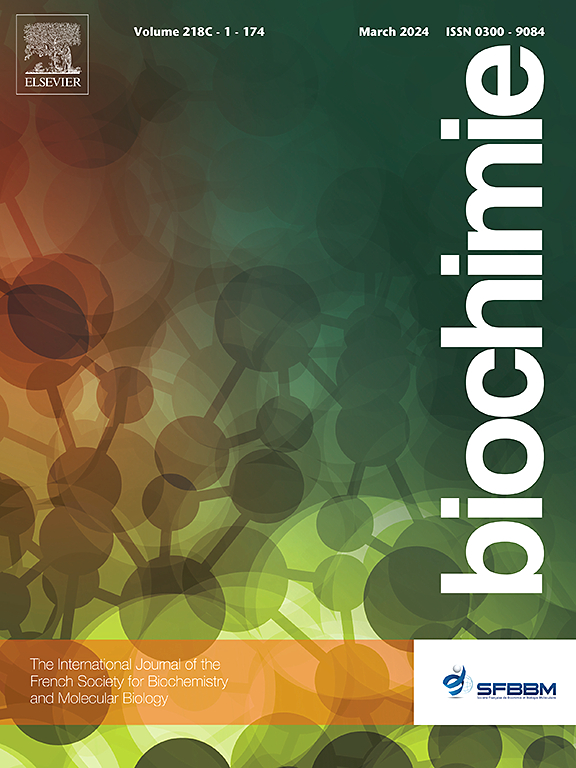The substrate preferences and “counting” mode of the cyanobacterial ω3 (Δ15) acyl-lipid desaturase
IF 3
3区 生物学
Q2 BIOCHEMISTRY & MOLECULAR BIOLOGY
引用次数: 0
Abstract
Fatty acid desaturases (FADs) belong to of the oxygenase superfamily. They play important roles in metabolic pathways and adaption mechanisms in a wide range of organisms, including bacteria and humans. These enzymes dehydrogenate a single bond in the acyl chain of fatty acids (FAs), forming a double bond. Multiple parameters influence the precise position of double bond formation and acyl chain docking in the catalytic pocket of various FADs, such as the length of an acyl chain, the position of previously generated double bonds, the location of the enzyme's metal catalytic site, and so on. The “counting” mode differs from one FAD to another. The cyanobacterium Synechocystis sp. strain PCC 6803 has four FADs (Δ9, Δ12, Δ6, and Δ15 or ω3) that synthesize mono-, di-, tri-, and tetraenoic FAs. The substrate preferences and “counting” modes for the first three FADs have been identified, but the substrate specificity for the terminal ω3-FAD remains uncertain. We used molecular cloning, heterologous expression with exogenous FAs, and molecular docking to explore the substrate selectivity and counting mode of ω3-FAD. Our results show that ω3-FAD “counts” from the carboxyl (Δ) end, introduces a double bond between 15 and 16 atoms, and requires a specific acyl substrate configuration with two pre-existing double bonds at Δ9 and Δ12 positions.
蓝藻ω3 (Δ15)酰基脂质去饱和酶的底物偏好和计数模式。
脂肪酸去饱和酶(FADs)属于加氧酶超家族。它们在包括细菌和人类在内的多种生物的代谢途径和适应机制中发挥重要作用。这些酶使脂肪酸酰基链中的单键脱氢,形成双键。影响各种FADs催化口袋中双键形成和酰基链对接的精确位置有多个参数,如酰基链的长度、先前生成的双键的位置、酶的金属催化位点的位置等。“计数”模式因FAD而异。蓝细菌胞囊藻属菌株PCC 6803具有四个fad (Δ9, Δ12, Δ6和Δ15或ω3),可合成单、二、三和四烯脂肪酸。已经确定了前三个fad的衬底偏好和“计数”模式,但终端ω3-FAD的衬底特异性仍然不确定。采用分子克隆、外源FAs外源表达、分子对接等方法探索ω3-FAD的底物选择性和计数模式。我们的研究结果表明,ω3-FAD从羧基(Δ)端开始“计算”,在15和16个原子之间引入一个双键,并且需要一个特定的酰基底物构型,在Δ9和Δ12位置有两个预先存在的双键。
本文章由计算机程序翻译,如有差异,请以英文原文为准。
求助全文
约1分钟内获得全文
求助全文
来源期刊

Biochimie
生物-生化与分子生物学
CiteScore
7.20
自引率
2.60%
发文量
219
审稿时长
40 days
期刊介绍:
Biochimie publishes original research articles, short communications, review articles, graphical reviews, mini-reviews, and hypotheses in the broad areas of biology, including biochemistry, enzymology, molecular and cell biology, metabolic regulation, genetics, immunology, microbiology, structural biology, genomics, proteomics, and molecular mechanisms of disease. Biochimie publishes exclusively in English.
Articles are subject to peer review, and must satisfy the requirements of originality, high scientific integrity and general interest to a broad range of readers. Submissions that are judged to be of sound scientific and technical quality but do not fully satisfy the requirements for publication in Biochimie may benefit from a transfer service to a more suitable journal within the same subject area.
文献相关原料
公司名称
产品信息
阿拉丁
19:1Δ10
 求助内容:
求助内容: 应助结果提醒方式:
应助结果提醒方式:


